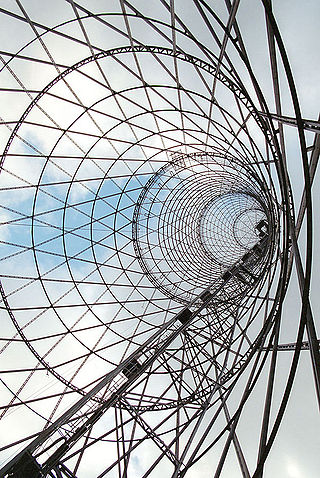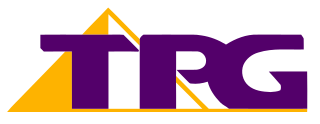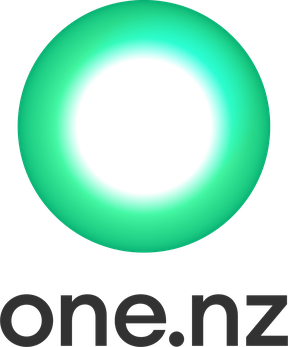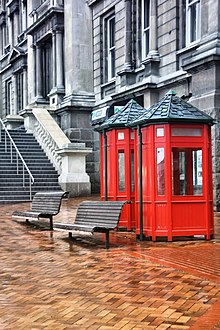
Like most countries and territories in Oceania, telecommunications in the Cook Islands is limited by its isolation and low population, with only one major television broadcasting station and six radio stations. However, most residents have a main line or mobile phone. Its telecommunications are mainly provided by Telecom Cook Islands, who is currently working with O3b Networks, Ltd. for faster Internet connection.
Telecommunications in France are highly developed. France is served by an extensive system of automatic telephone exchanges connected by modern networks of fiber-optic cable, coaxial cable, microwave radio relay, and a domestic satellite system; cellular telephone service is widely available, expanding rapidly, and includes roaming service to foreign countries.
Telecommunications in Ireland operate in a regulated competitive market that provides customers with a wide array of advanced digital services. This article explores Ireland's telecommunications infrastructure including: fixed and mobile networks, The voice, data and Internet services, cable television, developments in next-generation networks and broadcast networks for radio and television.

The telecommunications in Russia has undergone significant changes since the 1980s, radio was a major new technology in the 1920s, when the Communists had recently come to power. Soviet authorities realized that the "ham" operator was highly individualistic and encouraged private initiative – too much so for the totalitarian regime. Criminal penalties were imposed but the working solution was to avoid broadcasting over the air. Instead radio programs were transmitted by copper wire, using a hub and spoke system, to loudspeakers in approved listening stations, such as the "Red" corner of a factory. This resulted in thousands of companies licensed to offer communication services today. Due to the enormous size of the country Russia today, the country leads in the number of TV broadcast stations and repeaters. The foundation for liberalization of broadcasting was laid by the decree signed by the President of the USSR in 1990. Telecommunication is mainly regulated through the Federal Law "On Communications" and the Federal Law "On Mass Media"

Telecommunications infrastructure in South Africa provides modern and efficient service to urban areas, including cellular and internet services. The Independent Communications Authority of South Africa (ICASA) is the watchdog of the telecommunications in the country.
Telecommunications in the United Kingdom have evolved from the early days of the telegraph to modern broadband and mobile phone networks with Internet services.
In Venezuela the first law on telecommunications was approved in 1940. It identified the responsibility of the state in regard to telephone and other telecommunication systems, including radio and television services.
Portugal has a modern and flexible telecommunications market and a wide range of varied media organisations. The regulatory body overseeing communications is called ANACOM.

Telecommunications in Australia refers to communication in Australia through electronic means, using devices such as telephone, television, radio or computer, and services such as the telephony and broadband networks. Telecommunications have always been important in Australia given the "tyranny of distance" with a dispersed population. Governments have driven telecommunication development and have a key role in its regulation.

Eircom Limited, trading as Eir, is a large fixed, mobile and broadband telecommunications company in Ireland. The now privatised company, which is currently incorporated in Jersey, traces its origins to the Ireland's former state-owned monopoly telecommunication provider Telecom Éireann and its predecessors, P&T and before the foundation of the state, the telecommunications division of the GPO. It remains the largest telecommunications operator in Ireland and has overseas operations focused on the business and corporate telecom markets in the United Kingdom. The company was in majority state ownership until 1999, when it was privatised through a floatation on the Irish and New York Stock Exchanges.

Spark New Zealand Limited is a New Zealand telecommunications and digital services company providing fixed-line telephone services, mobile phone services, broadband, and digital technology services including cloud, security, digital transformation, and managed services. Its customers range from consumers to small - medium business, government agencies and large enterprise clients. It was formerly known as Telecom New Zealand until it was rebranded to Spark in 2014. It has operated as a publicly traded company since 1990. Spark's mobile network reaches 98% of New Zealand, with over 2.5 million mobile connections and 704,000 broadband connections

TPG is an Australian internet service provider that specialises in consumer and business internet services as well as mobile telephone services. As of August 2015, TPG is the second largest internet service provider in Australia and is the largest mobile virtual network operator. As such, it has over 671,000 ADSL2+ subscribers, 358,000 landline subscribers and 360,000 mobile subscribers, and owns the second largest ADSL2+ network in Australia, consisting of 391 ADSL2+ DSLAMs. It also operates in New Zealand.

StarHub Limited, commonly known as Starhub, is a Singaporean multinational telecommunications conglomerate and one of the major telcos operating in the country. Founded in 1998, it is listed on the Singapore Exchange (SGX).

One New Zealand Group Limited, stylised as One NZ, is a New Zealand telecommunications company. One NZ is the largest wireless carrier in New Zealand, accounting for 38% of the country's mobile share market in 2021.
Internet access is widely available in New Zealand, with 94% of New Zealanders having access to the internet as of January 2021. It first became accessible to university students in the country in 1989. As of June 2018, there are 1,867,000 broadband connections, of which 1,524,000 are residential and 361,000 are business or government.

Telecom Armenia OJSC is an Armenian broadband and telecommunications company. Telecom Armenia, an integrated telecommunications services operator, is headquartered in Yerevan.

The XT Network was a brand name for a UMTS and LTE mobile network run by Spark New Zealand . The network was initially built nationwide on WCDMA/UMTS 850 MHz, with 2100 MHz infill in major urban areas. The UMTS network is HSPA+ enabled, with a maximum downlink transmission rate of 21.1 Mbit/s and an uplink rate of 5.2 Mbit/s attainable for capable hardware. HSPA+ has a theoretical maximum of 56 Mbit/s download speed and 22 Mbit/s upload speed. Then under Spark 4G LTE is being built out. The network is not 2G capable, Telecom never operated a public GSM network.

2degrees is a New Zealand telecommunications provider. Its mobile network launched on 4 August 2009 after nine years of planning. 2degrees offers prepaid and pay-monthly mobile services, as well as fixed-line phone and broadband services. 2degrees is the third-largest wireless carrier in New Zealand, with 1.3 million subscribers as of July 2015.
3G mobile telephony was relatively slow to be adopted globally. In some instances, 3G networks do not use the same radio frequencies as 2G so mobile operators must build entirely new networks and license entirely new frequencies, especially so to achieve high data transmission rates. Other delays were due to the expenses of upgrading transmission hardware, especially for UMTS, whose deployment required the replacement of most broadcast towers. Due to these issues and difficulties with deployment, many carriers delayed acquisition of these updated capabilities.
Chorus is a provider of telecommunications infrastructure throughout New Zealand. It is listed on the NZX stock exchange and is in the NZX 50 Index. The company owns the majority of telephone lines and exchange equipment in New Zealand; and was responsible for building approximately 70% of the country's fibre-optic UFB network, receiving a government subsidy of $929 million to do so.













